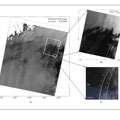Oceanic internal waves play an important role in nutrient distribution, primary productivity, acoustic propagation, coral reef growth, and submarine navigation. It is very difficult to measure the internal wave field because it has a complex three-dimensional structure and its motion is affected both by the structure of vertical stratification and by horizontal mean currents.
Oceanic internal waves play an important role in nutrient distribution, primary productivity, acoustic propagation, coral reef growth, and submarine navigation. It is very difficult to measure the internal wave field because it has a complex three-dimensional structure and its motion is affected both by the structure of vertical stratification and by horizontal mean currents.
In addition, the horizontal scale of internal wave is on the order of tens of km, too big to be observed entirely by in situ measurements. On the other hand, the vertical scale of internal waves is only a few tens of meters, too small to be simulated by the global ocean circulation models. Satellite remote sensing has been a vital tool for internal wave study due to their large coverage and high spatial resolution.
The South China Sea is an ideal region for studying large-amplitude internal wave generation, propagation, and evolution of internal waves. The internal waves travel thousand km from Luzon Strait to Hainan Island in the South China Sea. During these long journeys, internal waves could be imaged by satellite synthetic aperture radar (SAR) images. Typically, for one internal wave packet, only a snap shot of the wave field is obtained due to the low temporal resolution of the SAR satellite. Therefore, the internal wave phase speed cannot be accurately determined from one single-satellite SAR image, which only represents a static view of the two-dimensional internal wave field.
